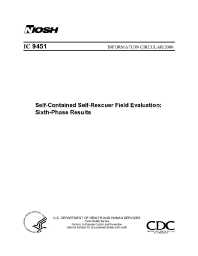Mining Publication: Self-Contained Self-Rescuer Field Evaluation: Sixth-Phase Results
Original creation date: July 2000
The National Institute for Occupational Safety and Health (NIOSH), Pittsburgh Research Laboratory, has undertaken a study to determine how well self-contained self-rescuers (SCSRs), deployed in accordance with Federal regulations (30 CFR 75.1714), hold up in the underground environment with regard to both physical damage and aging. This report presents findings regarding laboratory-tested SCSRs in the sixth phase of testing from mid-1996 to early 1998. The SCSRs were tested on human subjects and on a breathing and metabolic simulator. These results indicate that most of the apparatus, if they pass their inspection criteria, perform satisfactorily. However, the deployed CSE SR-100s exhibited significantly higher inhaled CO2 levels than new units, as in the previous phase. This will cause higher ventilation rates in most users, which will, in turn, result in higher breathing pressures, possibly causing users to prematurely remove the apparatus. CSE Corp. has developed a noise test that can identify apparatus suffering from chemical-bed degradation causing the early CO2 breakthrough. This test was added to the inspection criteria for the SR-100. In addition, several of the MSA Portal-Packs that passed their inspection criteria were found to have KO2 dust in their mouthpieces. Further investigations by NIOSH and the Mine Safety and Health Administration confirmed these findings, which resulted in the decertification of the apparatus and their removal from service.
Authors: N Kyriazi, JP Shubilla
Information Circular - July 2000
NIOSHTIC2 Number: 20000620
Pittsburgh, PA: U.S. Department of Health and Human Services, Public Health Service, Centers for Disease Control and Prevention, NIOSH, DHHS (NIOSH) Publication No. 98-1998, Information Circular 9451, 2000 Jul; :1-13
See Also
- How to Operate a Refuge Chamber: A Quick Start Guide
- I Can't Get Enough Air! Proper Self-contained Self-rescuer Usage
- Probability of Making a Successful Mine Escape While Wearing a Self-Contained Self-Rescuer
- Refuge Chamber Expectations Training - 1.0
- Self-Contained Self-Rescuer Field Evaluation: Fifth-Phase Results
- Self-Contained Self-Rescuer Field Evaluation: First-Year Results of 5-Year Study
- Self-Contained Self-Rescuer Field Evaluation: Fourth-Phase Results
- Self-Contained Self-Rescuer Field Evaluation: Results From 1982-90
- Self-Contained Self-Rescuer Field Evaluation: Seventh-Phase Results
- Self-Contained Self-Rescuer Long Term Field Evaluation Tenth Phase Results
- Content source: National Institute for Occupational Safety and Health, Mining Program


 ShareCompartir
ShareCompartir
